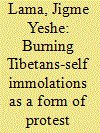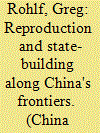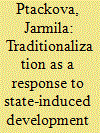| Srl | Item |
| 1 |
ID:
116202


|
|
|
| 2 |
ID:
079928


|
|
|
|
|
| Publication |
2007.
|
| Summary/Abstract |
This article analyzes population resettlement to western China during contemporary times within a historical framework that emphasizes gender. During the 1950s most relocatees to Qinghai were men, following the historical pattern set by Qing policies. Empirical data also show that the PRC government explicitly recruited women for relocation to border and remote areas. Women were moved to western regions as somewhat gender-neutral workers and also to serve in their traditional roles as wives and mothers. In both roles, women were a crucial component in state-building policies in border and remote areas. In fact, because sovereignty could not be permanently established without a naturally reproducing population, one can argue that reproduction was, and is, a basic component of state-building-an assertion that gets little attention in analyses of social and political change in border regions. This article describes the consolidation phase of territorial expansion as a feminine or yin process that relied upon incremental, organic growth, or "soft" assertions of power. Government documents, published materials, census records, and journalistic reporting are used to demonstrate these patterns and processes.
|
|
|
|
|
|
|
|
|
|
|
|
|
|
|
|
| 3 |
ID:
168834


|
|
|
|
|
| Summary/Abstract |
The current state-induced and top-down-implemented development and modernization of the predominantly rural areas of western China can be perceived as a clear demonstration of Chinese power in Tibetan areas, resulting in the repression of expressions of minority culture. This article argues that the local population’s various practices of traditionalization, as demonstrated through an emphasis on the maintenance or (re)invention of representative cultural forms can be understood as efforts to counteract the socio-economic and cultural assimilation measures or even as a form of political resistance. At the same time, in the context of the economic opportunities brought on by the rapid development, in tourism for example, traditionalization has become an important economic asset for both the state and local Tibetans. These (revived) traditions could enhance cultural awareness among visitors to minority areas and strengthen local people’s sense of cultural security and their self-understanding as Tibetans.
|
|
|
|
|
|
|
|
|
|
|
|
|
|
|
|